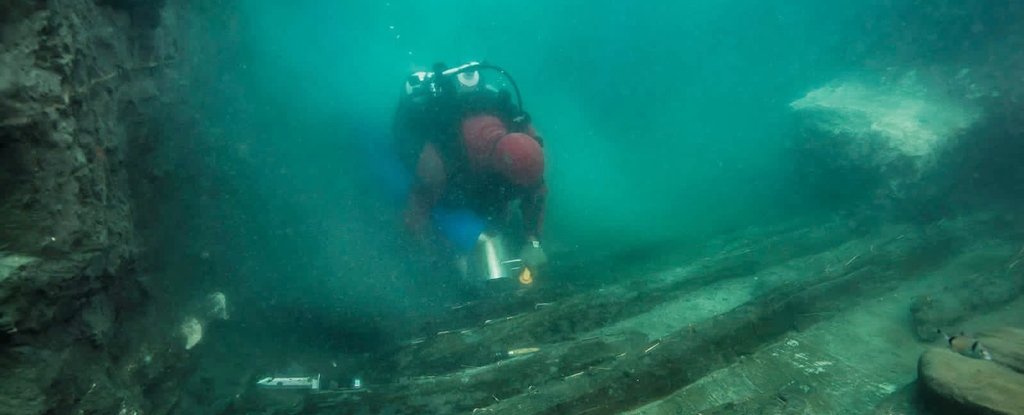
Archaeologists discovered the 2,200-year old wreck of an ancient Egyptian ship, which was struck by giant blocks from the temple of Amun.The so-called galley and a burial ground were found under the Mediterranean Sea in Thonis Heracleion. This was a city that had fallen into the sea long ago.This ship is known as a fast galley. It's a vessel with a large sail and would have been driven to high speeds by a group of oarsmen. The newly discovered fast galley measures 82 feet (25 m) in length and has a flat keel. This feature is common among ancient vessels that navigated along the Nile River.The European Institute for Underwater Archaeology stated that the "famous temple of Amun" sank the vessel after it was struck by large blocks.(Christoph Gerigk/FranckGoddio/Hilti Foundation)Above: Extensive offerings were found in the cemetery. This photo shows what appears to be images of waves in the decorated pot.Similar: 8 sunken settlements under the wavesAccording to the Egyptian Ministry of Tourism and Antiquities, this "cataclysmic" event was most likely an earthquake. The temple is just 16 feet (5 meters) away from the galley.To locate the object, researchers used a different type of sonar.Franck Goddio (president of the European Institute for Underwater Archaeology) stated in the institute's statement that "fast galley finds from this period are extremely rare."(Christoph Gerigk/FranckGoddio/Hilti Foundation)Above: The gold amulet depicts Bes, an Egyptian god associated to fertility and childbirth. It was found in the burial ground. Images of this god were sometimes used by ancient Egyptians to protect young children and women giving birth.This mortise-and tenon method was used to build the ship. Pieces of wood with protrusions (called tenons) are placed in pieces of wood that have holes (called mortises) cut into them. This results in a ship constructed of sections of wood that interlock like a puzzle. It is not known what cargo the galley contained when it went down.Burial groundThe archaeologists discovered a burial ground at the site of the sunken city. It was used as far back 2400 years ago. The archaeologists found intricately decorated pottery, with one piece that appeared to have images of waves on it.An archaeologist also discovered a gold amulet that depicted Bes, an Egyptian god associated to childbirth and fertility. Images of the god were used by ancient Egyptians to protect children and women giving birth.A large tumulus was used to cover the burial ground. This was a pile of stones that was often used in ancient times to indicate the location of burials.(Christoph Gerigk/FranckGoddio/Hilti Foundation)Above: Blocks of the Temple of Amun were thrown onto the galley and sank the ship.Egyptian and Greek influencesThe city that was discovered is known today as Thonis-Heracleion. It was once called Thonis by its Egyptian inhabitants, and Heracleion by its Greek inhabitants.A series of earthquakes caused the city to slowly sink into the sea until it was submerged around 1,000 years ago.At a time when many Greeks came to Egypt, bringing with them their cultural traditions, the city thrived. Alexander the Great conquered Egypt in 332 BCE. A line of rulers derived from one of his generals would then rule Egypt for three centuries.Archaeologists from the Antiquities Ministry, the European Institute for Underwater Archaeology and the Antiquities Ministry discovered the city again in 19992000. Since then, they have been studying the remains.Similar content:In photos: King Tut's life and deathPhotos: An ancient Egyptian general's grave discovered in SaqqaraPhotos: 3300-year-old Egyptian carvingLive Science originally published this article. You can read the original article here.
